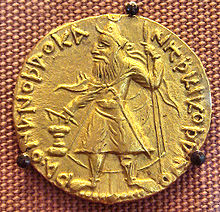
Kanishka
Kushan emperor (c. 127–150) / From Wikipedia, the free encyclopedia
Dear Wikiwand AI, let's keep it short by simply answering these key questions:
Can you list the top facts and stats about Kanishka?
Summarize this article for a 10 year old
Kanishka I, [lower-alpha 1] also known as Kanishka the Great,[5] was an emperor of the Kushan dynasty, under whose reign (c. 127–150 CE) the empire reached its zenith.[6] He is famous for his military, political, and spiritual achievements. A descendant of Kujula Kadphises, founder of the Kushan empire, Kanishka came to rule an empire extending from Central Asia and Gandhara to Pataliputra on the Gangetic plain. The main capital of his empire was located at Puruṣapura (Peshawar) in Gandhara, with another major capital at Mathura. Coins of Kanishka were found in Tripuri (present-day Jabalpur).[7]
| Kaniṣka, Kanishka | |
|---|---|
| Kushan emperor | |
 Gold coin of Kanishka. Greco-Bactrian legend: ϷΑΟΝΑΝΟϷΑΟ ΚΑΝΗϷΚΙ ΚΟϷΑΝΟ Shaonanoshao Kanishki Koshano "King of Kings, Kanishka the Kushan". British Museum. | |
| Reign | 2nd century (c. 127–150 CE) |
| Predecessor | Vima Kadphises |
| Successor | Huvishka |
| Born | Possibly Khotan, present-day Xinjiang, China (per Chinese chronicles)[1][2][3] or Kashmir[3] |
| Dynasty | Kushan |
Although he never converted to the religion, his conquests and patronage of Buddhism played an important role in the development of the Silk Road, and in the transmission of Mahayana Buddhism from Gandhara across the Karakoram range to China. Around 127 CE, he replaced Greek with Bactrian as the official language of administration in the empire.[8]
Earlier scholars believed that Kanishka ascended the Kushan throne in 78 CE, and that this date was used as the beginning of the Saka calendar era. However, historians no longer regard this date as that of Kanishka's accession. Falk estimates that Kanishka came to the throne in 127 CE.[9]